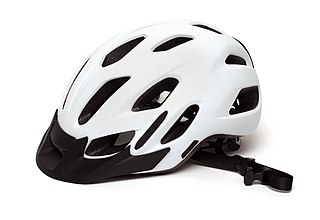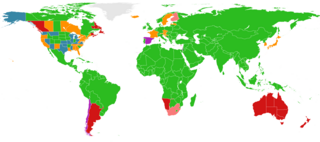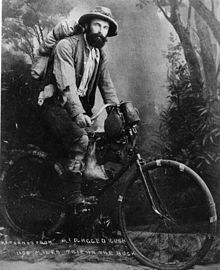
A bicycle, also called a pedal cycle, bike, push-bike or cycle, is a human-powered or motor-assisted, pedal-driven, single-track vehicle, with two wheels attached to a frame, one behind the other. A bicycle rider is called a cyclist, or bicyclist.

Cycling, also known as bicycling or biking, is the activity of riding a bicycle or other type of cycle. It encompasses the use of human-powered vehicles such as balance bikes, unicycles, tricycles, and quadricycles. Cycling is practised around the world for purposes including transport, recreation, exercise, and competitive sport.

A bicycle helmet is a type of helmet designed to attenuate impacts to the head of a cyclist in collisions while minimizing side effects such as interference with peripheral vision.

Bicycle Network is an Australian charity, one of the largest cycling membership organisations in the world, whose mission is to have More People Cycling More Often. Before 2011 it was known as Bicycle Victoria.

Cycling in Melbourne is an important mode of transport, fitness, sport and recreation in many parts of the city. After a period of significant decline through the mid to late 20th century, additional infrastructure investment, changing transport preferences and increasing congestion has resulted in a resurgence in the popularity of cycling for transport. This is assisted by Melbourne's natural characteristics of relatively flat topography and generally mild climate.

Road bicycle racing is the cycle sport discipline of road cycling, held primarily on paved roads. Road racing is the most popular professional form of bicycle racing, in terms of numbers of competitors, events and spectators. The two most common competition formats are mass start events, where riders start simultaneously and race to a set finish point; and time trials, where individual riders or teams race a course alone against the clock. Stage races or "tours" take multiple days, and consist of several mass-start or time-trial stages ridden consecutively.

Vehicular cycling is the practice of riding bicycles on roads in a manner that is in accordance with the principles for driving in traffic, and in a way that places responsibility for safety on the individual.
Lisa Mathison is a professional cyclist from Brisbane, Queensland, Australia, specialising in cross-country mountain bike racing. She started competitive cycling at the age of 13 in 1998 and came to national and international attention in 2002 when she won the U19 cross-country World Championships in Austria. In 2003, she successfully defended her Under 19 world champion title in Switzerland. Her achievements in mountain biking won her a Union Cycliste Internationale (UCI) scholarship under the tutelage of legendary Swiss ex-pro, Chantal Daucourt, at the coaching facility in Aigle, Switzerland.

Cycling Australia (CA), the trading name of the Australian Cycling Federation Inc, was the national governing body for bicycle racing in Australia, and represented the interests of affiliated cycling clubs and State federations. It covered the disciplines of road, track, mountain bike, cyclo-cross, and BMX.
The Bicycle Federation of Australia (BFA) was the peak Australian body representing non-competitive cyclists, and directly represented over 20,000 cyclists who belonged to its affiliated groups in all states of Australia. Established in 1979 as a non-profit organisation, it advocated and lobbied Governments and the private sector for the several million Australians who ride bicycles for recreation, sport and transport. It discontinued its operations in February 2010.

Bicycle safety is the use of road traffic safety practices to reduce risk associated with cycling. Risk can be defined as the number of incidents occurring for a given amount of cycling. Some of this subject matter is hotly debated: for example, which types of cycling environment or cycling infrastructure is safest for cyclists. The merits of obeying the traffic laws and using bicycle lighting at night are less controversial. Wearing a bicycle helmet may reduce the chance of head injury in the event of a crash.
Bicycle helmets have been mandatory for bicycle riders of all ages in New Zealand since January 1994.

Cycling in Sydney, New South Wales, Australia takes place for recreation, commuting and as a sport. Sydney has a hilly topography and so may require a slightly higher level of fitness from cyclists than flatter cities such as Melbourne and Canberra. Sydney depends heavily on motor vehicles where traffic and public transport operate at capacity. This means that cyclist are often competing with motorists for limited space on busier roads, and for limited government resources for expenditure on road infrastructure. In its favour, Sydney has a generally mild climate and there are active cycling groups.
Cycling in the Australian state of New South Wales is a common form of recreation.

Australia was the first country to make wearing bicycle helmets mandatory. The majority of early statistical data regarding the effectiveness of bicycle helmets originated from Australia. Their efficacy is still a matter of debate.

The wearing of bicycle helmets and attitudes towards their use vary around the world. The effects of compulsory use of helmets are disputed. Only the four countries of Argentina, Cyprus, Australia, and New Zealand currently both require and enforce universal use of helmets by cyclists. In some other jurisdictions partial rules apply, such as only for children, in certain states or sub-national divisions, or under other limited conditions.

Bicycle law is the parts of law that apply to the riding of bicycles.
The National Road Series is a series of bicycle races held each year in Australia, constituting the chief domestic road racing competition for cyclists.

Cycling in Canberra, the capital city of Australia, is a popular means of transportation, sporting and recreational pass time. Commuting in the city is supported by an extensive network of urban cycleways and on-street bicycle lanes. As a city established in the 20th century, Canberra's development was heavily influenced by the automobile for much of its history. The popularity of cycling in the city has increased dramatically in the 21st century with growing awareness of environmental issues, government policy supporting active transport and investment in cycling infrastructure. This has led to the development of a strong cycling culture.

Gravel cycling, gravel biking or gravel grinding is a sport, or a leisure activity, in which participants ride bicycles mostly on gravel roads. Sometimes, specially designed gravel bikes are used; in other cases, any bicycle capable of covering the terrain can be used.

















